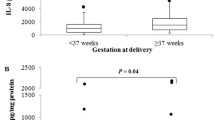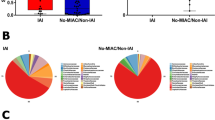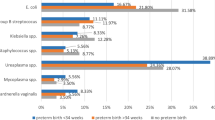Abstract
Purpose
To evaluate vaginal microflora and interleukin-1β (IL-β), interleukin-6 (IL-6), interleukin-8 (IL-8) and tumor necrosis factor-alpha (TNF-α) concentrations in the cervicovaginal fluid of a group of pregnant women in preterm labor when compared with a group of full-term pregnant women not yet in labor.
Method
Case–control study performed in a University tertiary referral maternity in Campinas, Brazil with 45 pregnant women in preterm labor and 45 full-term pregnant women not in labor. All patients underwent speculum examination for the collection of cervicovaginal fluid. Bacterial vaginosis (BV) was diagnosed according to the criteria of Amsel and Nugent. Culture was performed for group B streptococcus (GBS) and lactobacilli, and hybrid capture assay for screening for chlamydial and gonococcal infection. Cytokine concentrations were measured using ELISA technique. Statistical analysis was performed using χ2, Fisher’s exact, and crude and adjusted odds ratios. Significance level was defined at 5%. The main outcome measures were cervicovaginal cytokines in preterm labor.
Results
IL-6 and IL-8 were significantly associated with preterm labor. The changes in vaginal microflora, as well as BV and GBS, were more frequent in women in preterm labor, although BV and GBS showed no statistical significance. The presence of Candida sp., absence of lactobacilli, positive screening for chlamydial and gonococcal infection and the presence of IL-1β and TNF-α were not associated with preterm labor.
Conclusions
IL-6 and IL-8 and the presence of any type of vaginal infection were the factors that were significantly associated with preterm labor.
Similar content being viewed by others
Abbreviations
- BMI:
-
Body mass index
- BV:
-
Bacterial vaginosis
- CI:
-
Confidence interval
- CT:
-
Chlamydia trachomatis
- GBS:
-
Group B Streptococcus
- IL:
-
Interleukin
- LPS:
-
Lipopolysaccharide
- NG:
-
Neisseria gonorrhea
- OR:
-
Odds ratio
- PBS:
-
Phosphate buffered saline
- RLU:
-
Relative light unit
- TNF-α:
-
Tumor necrosis factor-alpha
- UNICAMP:
-
University of Campinas
- UTI:
-
Urinary tract infection
References
Goldenberg RL, Culhane JF, Iams JD, Romero R (2008) Epidemiology and causes of preterm birth. Lancet 371:75–84
Reedy NJ (2007) Born too soon: the continuing challenge of preterm labor and birth in the United States. J Midwifery Womens Health 52:281–290
Larsson PG, Fahraeus L, Carlsson B, Jakobsson T, Forsum U (2007) Predisposing factors for bacterial vaginosis, treatment efficacy and pregnancy outcome among term deliveries, results from a preterm delivery study. BMC Womens Health 7:20
Fortunato SJ, Menon RP, Swan KF, Menon R (1996) Inflammatory cytokine (interleukins 1, 6, and 8 and tumor necrosis factor-alpha) release from cultured human fetal membranes in response to endotoxic lipopolysaccharide mirrors amniotic fluid concentrations. Am J Obstet Gynecol 174:1855–1861
Mattsby-Baltzer I, Platz-Christensen JJ, Hosseini N, Rosén P (1998) IL-1β, IL-6, TNFα fetal fibronectin and endotoxin in the lower genital tract of pregnant women with bacterial vaginosis. Acta Obstet Gynecol Scand 77:701–706
Denison FC, Calder AA, Kelly RW (1999) The action of prostaglandin E2 on the human cervix: stimulation of interleukin 8 and inhibition of secretory leukocyte protease inhibitor. Am J Obstet Gynecol 180:614–620
Basso B, Giménez F, López C (2005) IL-1β, IL-6 and IL-8 levels in gyneco-obstetric infections. Infect Dis Obstet Gynecol 13:207–211
Jun JK, Yoon BH, Romero R, Kim M, Moon JB, Ki SH et al (2000) Interleukin 6 determinations in cervical fluid have diagnostic and prognostic value in preterm premature rupture of membranes. Am J Obstet Gynecol 183:868–873
Rizzo G, Capponi A, Rinaldo D, Tedeschi D, Arduini D, Romanini C (1996) Interleukin-6 concentrations in cervical secretions identify microbial invasion of the amniotic cavity in patients with preterm labor and intact membranes. Am J Obstet Gynecol 175:812–817
Doh K, Barton PT, Korneeva I, Perni SC, Bongiovanni AM, Tuttle SL et al (2004) Differential vaginal expression of interleukin 1 system cytokines in the presence of Mycoplasma hominis and Ureaplasma urealyticum in pregnant women. Infect Dis Obstet Gynecol 12:79–85
Tanaka Y, Narahara H, Takai N, Yoshimatsu J, Anai T, Miyakawa I (1998) Interleukin-1β and interleukin-8 in cervicovaginal fluid during pregnancy. Am J Obstet Gynecol 179:644–649
Kalinka J, Wasiela M, Sobala W, Brzezińska-Błaszczyk E (2005) Usefulness assessment of selected proinflammatory cytokines’ level in cervico-vaginal fluid of pregnant women as an early marker of preterm delivery. Ginekol Pol 76:704–712
Simcox R, Sin WT, Seed PT, Briley A, Shennan AH (2007) Prophylactic antibiotics for the prevention of preterm birth in women at risk: a meta-analysis. Aust N Z Obstet Gynaecol 47:368–377
Varma R, Gupta JK, James DK, Kilby MD (2006) Do screening-preventative interventions in asymptomatic pregnancies reduce the risk of preterm delivery—a critical appraisal of the literature. Eur J Obstet Gynecol Reprod Biol 127:145–159
Swadpanich U, Lumbiganon P, Prasertcharoensook W, Laopaiboon M (2008) Antenatal lower genital tract infection screening and treatment programs for preventing preterm delivery. Cochrane Database System Rev (2):CD006178
The Ministry of Health, Brazil (2000) High risk pregnancy. Technical guideline, 4th edn. The Ministry of Health, Brasilia, 164 p
Nugent RP, Krohn MA, Hillier SL (1991) Reliability of diagnosing bacterial vaginosis is improved by a standardized method of gram stain interpretation. J Clin Microbiol 29:297–301
Amsel R, Totten PA, Spiegel CA, Chen KC, Eschenbach D, Holmes KK (1983) Nonspecific vaginitis: diagnostic criteria and microbial and epidemiologic associations. Am J Med 74:14–22
Dowd J, Laham N, Rice G, Brennecke S, Permezel M (2001) Elevated interleukin-8 concentrations in cervical secretions are associated with preterm labour. Gynecol Obstet Invest 51:165–168
Goepfert AR, Goldenberg RL, Andrews WW, Hauth JC, Mercer B, Iams J et al (2001) The Preterm Prediction Study: association between cervical interleukin 6 concentrations and spontaneous preterm birth. National Institute of Child Health and Human Development Maternal-Fetal Medicine Units Network. Am J Obstet Gynecol 184:483–488
Kurkinen-Räty M, Ruokonen A, Vuopala S, Koskela M, Rutanen EM, Kärkkäinen T et al (2001) Combination of cervical interleukin -6 and -8, phosphorylated insulin-like growth factor-binding protein-1 and transvaginal cervical ultrasonography in assessment of the risk of preterm birth. BJOG 108:875–881
Coleman MA, Keelan JA, McCowan LM, Townend KM, Mitchell MD (2001) Predicting preterm delivery: comparison of cervicovaginal interleukin (IL)-1beta, IL-6 and IL-8 with fetal fibronectin and cervical dilatation. Eur J Obstet Gynecol Reprod Biol 95:154–158
Watcharaseranee N, Pinchantra P, Piyaman S (2006) The incidence and complications of teenage pregnancy at Chonburi hospital. J Med Assoc Thai 89:18–23
Hendler I, Goldenberg RL, Mercer BM, Iams JD, Meis PJ, Moawad AH et al (2005) The Preterm Prediction Study: association between maternal body mass index and spontaneous and indicated preterm birth. Am J Obstet Gynecol 192:882–886
Schultz R, Read AW, Straton JA, Stanley FJ, Morich P (1991) Genitourinary tract infections in pregnancy and low birth weight: case-control study in Australian aboriginal women. BMJ 303:1369–1373
Kilpatrick SJ, Patil R, Connell J, Nichols J, Studee L (2006) Risk factors for previable premature rupture of membranes or advanced cervical dilation: a case control study. Am J Obstet Gynecol 194:1168–1174
Hitti J, Hillier S, Agnew KJ, Krohn MA, Reisner DP, Eschenbach DA (2001) Vaginal indicators of amniotic fluid infection in preterm labor. Obstet Gynecol 97:211–219
Donders GG, Van Bulck B, Caudron J, Londers L, Vereecken A, Spitz B (2000) Relationship of bacterial vaginosis and mycoplasmas to the risk of spontaneous abortion. Am J Obstet Gynecol 183:431–437
Simões JA, Giraldo PC, Ribeiro-Filho AD, Faundes A (1996) Prevalênica e Fatores de Risco associados às infecções cérvico-vaginais durante a gestação. Rev Bras Ginec Obstet 18:459–467
Guaschino S, De Seta F, Picolli M, Maso G, Alberico S (2006) Aetiology of perterm labor: bacterial vaginosis. BJOG 115:46–51
Nomura ML, Passini Júnior R, Oliveira UM (2005) Group B streptococcus colonization in preterm labor and preterm rupture of membranes. Int J Gynaecol Obstet 91:69–70
Hoyme UB, Saling E (2004) Efficient prematurity prevention is possible by pH-self measurement and immediate therapy of threatening ascending infection. Eur J Obstet Gynecol Reprod Biol 115:148–153
Mendelson CR (2009) Minirewiew: fetal-hormonal signaling in pregnancy and labor. Mol Endocrinol 23:947–954
Bélec L, Meillet D, Lévy M, Georges A, Tévi-Bénissan C, Pillot J (1995) Dilution assessment of cervicovaginal secretions obtained by vaginal washing for immunological assays. Clin Diagn Lab Immunol 2:57–61
Quesnel A, Cu-Uvin S, Murphy D, Ashley RL, Flanigan T, Neutra MR (1997) Comparative analysis of methods for collection and measurement of immunoglobulins in cervical and vaginal secretions of women. J Immunol Methods 202:153–161
Acknowledgments
The authors gratefully acknowledge the collaboration of Jossimara Polettini in performing the ELISA tests, Andréia Leal for her help in providing care for the patients included in the study and Sirlei Morais for collaborating in the statistical analysis. The financial support of the São Paulo Foundation for the Support of Research (FAPESP) is also gratefully acknowledged. Unfortunately, after the end of this study, Prof. J.A. Simoes died. All the authors would like to recognize his leadership in this topic.
Conflict of interest statement
None.
Author information
Authors and Affiliations
Corresponding author
Additional information
Deceased: Jose A. Simoes.
Rights and permissions
About this article
Cite this article
Discacciati, M.G., Simoes, J.A., Silva, M.G. et al. Microbiological characteristics and inflammatory cytokines associated with preterm labor. Arch Gynecol Obstet 283, 501–508 (2011). https://doi.org/10.1007/s00404-010-1427-z
Received:
Accepted:
Published:
Issue Date:
DOI: https://doi.org/10.1007/s00404-010-1427-z




